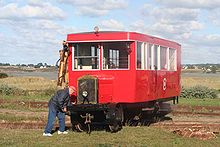SNCF X 5700
The X 5700 , also known as the Autorail Floirat , was a rail bus built in ten units for the French state railway Société nationale des chemins de fer français (SNCF).
prehistory
In the years after the Second World War , the SNCF looked for ways to revitalize and maintain rural branch lines by using economically viable small rail buses. Private railway companies had already put corresponding vehicles on the tracks in the 1920s. The Tramways des Deux Sèvres were pioneers , for whose meter-gauge network Georges Tartary converted former ambulance buses of the United States Army into rail buses shortly after the First World War . De Dion-Bouton created narrow-gauge rail buses between 1923 and 1932, whose close relationship with street buses was obvious. The total of 66 railcars of the JM series had a rotating device attached under the floor of the car that could be lowered onto the track, and could pull two-axle sidecars.
For traffic on standard-gauge tracks, the Michelin company developed light railcars with air-filled tires in the 1930s . The vehicles called Michelines , however, were designed for long-distance traffic; they were not suitable for use on low-traffic secondary routes. The X 5600 series was still in the development phase.
History and description
From the point of view of the SNCF, an attempt was made to convert a street bus into a rail vehicle. It offered sufficient capacity for secondary lines, had a proven, easy-to-maintain diesel engine and was inexpensive to purchase due to its series production. The prerequisites, however, were sufficient power to pull a trailer if necessary , a solid car body that met the safety requirements, and a track width similar to the standard railway gauge . In addition, it should have doors on both sides.
The choice fell on the type Floirat GAI B6 from Sylvain Floirat , a coachbuilder from Saint-Denis near Paris . It had doors on both sides of the car, and its 105 hp diesel engine was sufficiently powerful. The track width of the rear wheels, which mattered, was 1.47 m, only 2.5 cm above the standard track width. The brake worked with compressed air , 40 passengers could be transported at up to 80 km / h.
With the support of technicians from SNCF, the necessary adjustments were made at Floriat. They were kept as simple as possible in order to enable a dismantling to the road vehicle if necessary. In particular, they included the replacement of rubber tires with metal wheels and the front axle with a rigid axle . The brakes were modified in accordance with the lower friction between wheel and rail, and the bumpers were moved upwards at buffer height . The taillights were adjusted, an SNCF horn was installed, the wheel openings were closed with metal sheets and the roof ladders were attached to the side. In order to gain space, the number of seats was reduced from 40 to 34. Like the JM series, they were fitted with a rotating device under the floor of the car. The sidecars received a trailer coupling on the back . Below the ribbon of windows, the vehicles - with the exception of the railcar front - were painted red, otherwise gray.
With a consumption of 17 liters per 100 km, the rail bus proved to be very economical. Even with a fully loaded sidecar, it easily reached a speed of 70 km / h on the plain, but weakened on the ramps. Its too fragile construction turned out to be a big problem: In contrast to road traffic, where the tires absorbed some of the shocks, the vehicles suffered from the stress of rail traffic, especially since the tracks were often in poor condition shortly after the war.
Whereabouts
As early as 1949/50, the X 5700 were dismantled to street buses and replaced by rail buses of the X 5600 series .
Individual evidence
- ↑ a b c d e f g Clive Lamming: Trains de Légende: Les Réseaux français et la Naissance de la SNCF (1938-1950) . 2006, ISBN 2-8302-2147-8 , pp. 104 f .
- ^ WJK Davies: The Light Railway Railcar in Western Europe . Plateway Press, East Harling 2004, ISBN 1-871980-52-6 , pp. 85 f .
- ↑ WJK Davies: op. Cit. , P. 103 ff.
- ↑ Clive Lamming: op. Cit. , P. 82 f.
- ↑ Le conducteur d'autorails in: Ferrovissime No. 7, p. 14 ff.

